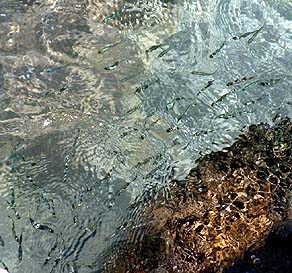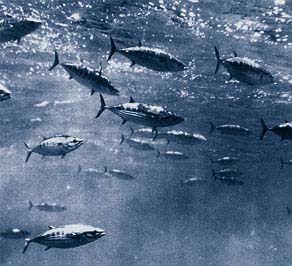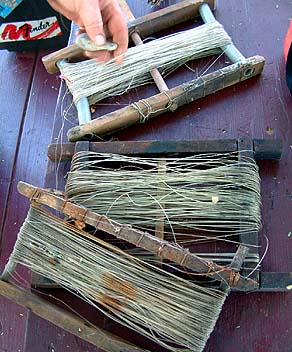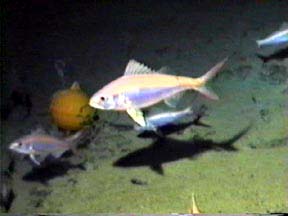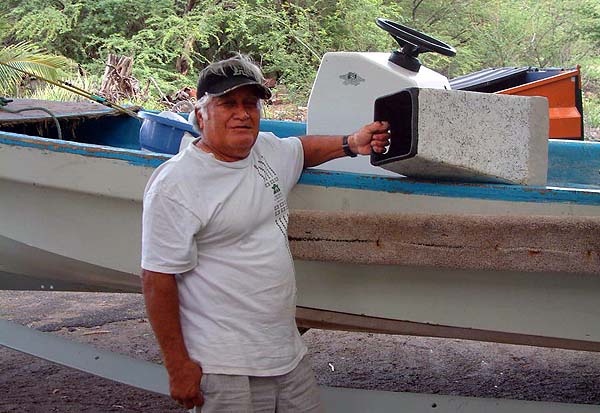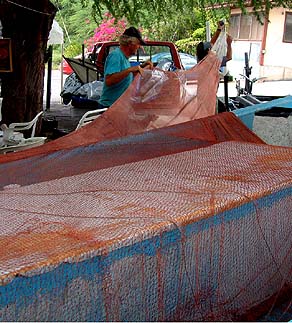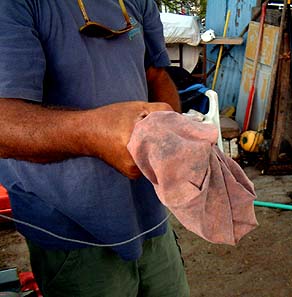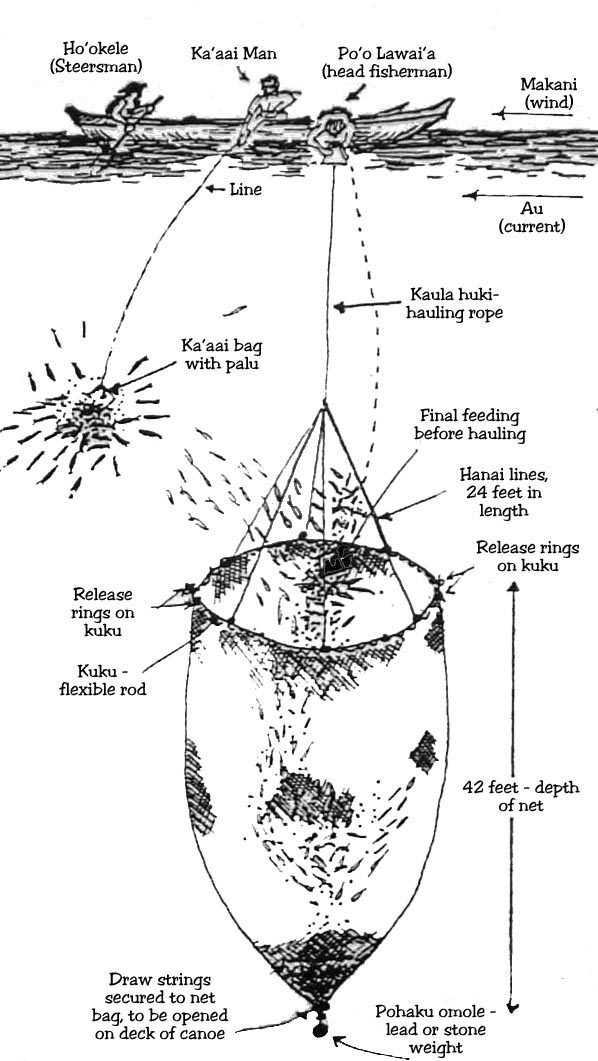 |
 |
 |
|||||
|
|
|||||||
| |
|
|
|
|
“The whole village fished,” Lala explains. “That was the living. You get all types of fishing. But those days, mostly they fished three types: aku, bottom fish and ‘opelu. That’s the only thing going to sell. Akule, manini, you could catch all kinds of reef fish if you want to. That’s only for home use. “Fishing is seasonal. Summertime when aku run, we go aku. ‘Opelu run, we go ‘opelu. ‘Opelu is during the winter. And the bottom fish, like onaga, paka, uku, that’s winter time.”
|
||
|
|
||
Aku Fishing:
“We’d catch nehu on the sand beach with surround nets," Lala says, "to use for aku bait. Before the sun comes up we surround them. Little tiny guys. Big net—small eye, but big surround net. We’d fill up the box full with nehu, then we go out for aku. We can load five boats sometime. We only had two aku boats, and one bottomfish boat. Load them up, and go out for aku. “You throw the bait out the back of the boat, with the spray, but the bait has to be alive. This brings the aku to the stern of the boat. To catch the aku, you pull them in using a bamboo pole with a big barbless hook on the end. Just jig ‘em in, just flip them right in."
|
|
|
“We come in, unload them on a big skiff, because a big skiff comes right to the sand. Shallow draft. Right on the sand, we’d load them up. There were also fish peddlers. They’re would be about twenty of them, lined up. We’d sell to the fish peddlers, and they’d take it all over,—to the plantation camps, whatever. We used to sell aku no problem. "And the leftover, we’d put in the ice house, freeze it, and ship it to Honolulu, to Hawaiian Tuna Packer. We used to charter the plane to Honolulu, pick up those aku we catch. Put them up in a freezer, up in the ice house in Kamuela. When we get enough, we ship it down to Tuna packers.”
|
| |
|
“When the aku boat would bring in the aku," Lani remembers, "everybody would go there and help them unload it from the little boat that they bring in to the shore, and then when you go in they give you an aku, everybody gets one aku to go home. I remember my mother used to drive them up and they had screen on the beach, and my job was to go down there and put it in the screen. "See, when you dry fish, you have to salt it first. You salt it over night and the next morning you soak it in the water to get most of the salt off. Then when you take it to the drier, where you dry it, you have to turn it upside down so the water will drain all out first. The meat part goes upside down so that you drain all the water out. The skin on top. You set them on like a window screen, it’s got to be up off the ground. And then you had to watch, because sometimes the cats will get them, then it’s tragic, so you got to watch that. So my job was to watch the drying screens. "Then after about an hour you would go down there and turn it up. And we eat a lot of dried aku like that. It was good. It was really good. We ate that with poi for lunch like that. Just dried from the sun. It was really good."
|
||
|
|
||
Line Fishing: “We owned a bottom-fishing boat,” Lala says, “and for bottom fish, we use hand lines. We don’t have weights. Hand lines to130 fathoms down for onaga. 80 fathoms for paka, I remember that. And we don’t have any depth recorder either. “When you go fishing, and the current is coming from the South, they say go to an area to do bottom fishing,” Papa points out. “You palu. Because when the current is going north, the palu will go north, but the fish go swim south. Because where you’re at, that’s where he’s going to end up.Over here is all reef, but some places don’t have reef. Sometimes you find a ko‘a, you got to be certain current, or no current at all. “When you ka‘ili [snatch, grab, take by force], you watch how the current goes, so you know where they hang out. So if you get good current, you palu—you send chum down—and then you just let it go a little while, first thing they all come in. Then you start pulling in, you have five hooks, ten hooks, whatever."
|
|
|
"But timing is important. You don’t go just any time; you got to know when the current is pulling. Soft current is the best. Because the fish don’t run against any strong pull. They wait for nice and soft current, for swim. So you have to know all of these kinds of things: It also depends on which phase of the moon. A lot of things you have to learn.” “The current, it’s usually south or north,” Lala agrees. “The south current, you go where the south current grounds are. North current, you go to where the north current grounds are. Where we used to go for onaga, you mark the heiau, and rivers. "So I know all the grounds from shore lines. Nowadays, well they got GPS, they got depth recorder, you can see the fish. So it’s a different story.”
|
|
|
|
|
‘Opelu fishing: “Winter, we go ‘opelu, like I do now with a net," Lala says. "That’s how they do it in olden times.We use a net to fish ‘opelu, using only two persons. You can do it yourself too. "It’s a big net, it’s huge. Like a big scoop net, with strings that hold it up. You can open the two ends and you pull it in. First we chum. We chum, feed them to the top. Then we drop this net down. You don’t drop your net down until you see maybe fifty pounds under your boat. Or a hundred pounds. "There’s a glass box there. We put it in, look into it, to see what we got, how many pounds eating. Get enough for catch when the fish come to about 30, 40, 50 pounds, then we drop the net down. Put ‘em down in the water about 10, 15 feet. Pull the line, and it opens like a square."
|
||
| |
||
"All these lines go on, they’re called kuku, you get about 5 feet apart. So the thing makes the net round. You just pull it up, unhitch both ends, that would bring the net in." “I feed them, chum it. My boat has the chum. So just chum it to feed it. If there’s a school there, we catch it; if there’s no school, then we go out to the next ground, next spot. Hawaiians call them ko‘a.” “When you feed at the ko‘a, then when the boat gets there, they’re always there, when you have the right current. We call it ‘au‘a, means the school just hang there, maybe 30 or 40 pounds I leave them alone, so I just feed them." ‘Au‘a is defined in the Hawaiian dictionary as "A kind of ‘opelu fish said to be larger than others in a school and hence more visible. When net fishermen see an ‘au‘a they know a school is present; the ‘au‘a then cannot be caught [he refuses].”
|
|
|
“‘Opelu, I’m still using my landmarks,” Lala continues, “mountains, rivers, we use all that for landmarks. I don’t use depth recorder, I go with the Hawaiian way: landmarks. And you have to know your current and everything. "We have names for fishing spots, like Red Hill, Black Point, Honokoa Gulch. You know these from what you see on the land. Take the mark from Red Hill, but you have to know how far out. I take the range from the heiau and the point, you go on the angle. Black Point is farther down. You line them up on the heiau. It goes out, I say 150 feet. We use the old mark, the point. All under 150 feet, amazing I tell you. I’m talking about ‘opelu . 150 feet. “You gotta find the reef and sand, because the ‘opelu runs along the reef and sand. I still do the ‘opelu the same route. Just go to certain grounds: Red Hill, Black Point, Red Rock, I get spots all over."
|
|
|
|
|
| “We fish ‘opelu at Honokoa Gulch. Just before the sun goes down, that’s when the ‘opelu come and gather. But you got to catch them just before the sun goes down, then they come like ants. Unbelievable, I tell you. And I hate to stay out there late until the sun goes down. But we stop at Honokoa Gulch, the last stop, just before the sun goes down. It’s like a gathering place there. You throw your chum down, oh, they come like bees, honey bees. “You have to study the current; if you don’t know the current, no sense to go out and fish. Well, maybe nowadays you get depth recorder, you can find the school. My boat doesn’t have a depth recorder, I still use the landmarks, it’s still pretty accurate. But today I don’t see too much fish come in! Not like before. “The ‘opelu, we sell it. We dry it. You can cook it any way. You can pan fry it. Oh, good! Too bad I don’t have one!”
|
||
|
|
||
Now we invite you to look at more local terminology regarding fish and fishing, presented in this chapter's Language page. Our next chapter focuses on the Land.
|
||
|
|
||
|
|
|
|
|
|

|
| Kawaihae Home | Map Library | Site Map | Hawaiian Islands Home | Pacific Worlds Home |
|
|
|
|
|
|
|||
| Copyright 2006 Pacific Worlds & Associates • Usage Policy • Webmaster |
|||

